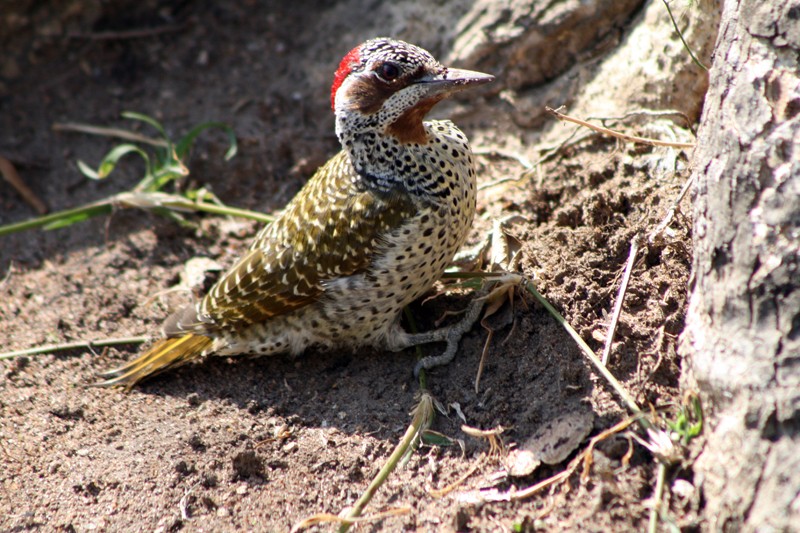Bennett's Woodpecker
A species of African Green Woodpeckers Scientific name : Campethera bennettii Genus : African Green Woodpeckers
Bennett's Woodpecker, A species of African Green Woodpeckers
Botanical name: Campethera bennettii
Genus: African Green Woodpeckers
Content
Description General Info
Description
Bennett's woodpecker is about 24 cm (9.4 in) long and weighs 61–84 g (2.2–3.0 oz). The male's forehead, crown and nape are red. The chin and throat are white. The upperparts are brown, yellow and white. The underparts are pale yellow, and there are dark spots on the breast and flanks. The eyes are red, the beak is grey, and the legs are bluish-green or grey-green. The female has a black forehead with white spots, and its ear coverts and throat are brown or blackish-brown. The juvenile bird has a black forehead and crown and darker upperparts. The subspecies capricorni is slightly larger, and its underparts have a deeper colour and fewer spots. 
Size
24 cm
Nest Placement
Cavity
Feeding Habits
Bennett's Woodpecker primarily consumes ants, termites and their eggs, occasionally eating other insects and larvae. Often forages in pairs or small groups, sometimes with glossy-starlings. Bennett's Woodpecker forages mostly on the ground in grassy areas, using gleaning and probing techniques, with about 70-85% of feeding efforts happening terrestrially.
Habitat
Bennett's Woodpecker prefers well-developed mature woodland and bush country within broad geographical regions of sub-Saharan Africa. Its preferred habitats include miombo (Brachystegia), gusu (Baikiaea), Acacia, and mopane woodlands. Commonly found in regions with sandy soils, these birds are adapted to diverse closed woodlands, often cohabiting with other species in valley woodlands. Bennett's Woodpecker can be found at elevations up to 1600 meters, particularly in eastern parts of Africa.
Dite type
Insectivorous
General Info
Feeding Habits
Bird food type
Behavior
Bennett's woodpecker is found singly, in pairs or in family groups. It mostly forages on the ground, either bare or with short grass, and also feeds in trees. It mostly eats ants and termites, including their eggs. Its calls include chuur notes, a series of wi-wi-wi-wi, kee-kee-kee or ddrahh, ddrahh, ddray-ay, ddray-ay, and a chattering wirrit-wirrit. Breeding occurs from August to February. The woodpecker excavates or reuses holes in trees. Three eggs are laid and then incubated for 15 to 18 days. 
Distribution Area
This woodpecker is found in Angola, Botswana, Burundi, Democratic Republic of the Congo, Malawi, Mozambique, Namibia, Rwanda, South Africa, Swaziland, Tanzania, Zambia, and Zimbabwe, and it has a patchy distribution. Its habitat is woodlands and bushes, including miombo, Baikiaea, Acacia and mopane woodlands. 
Species Status
The species has a stable population and there is no evidence of substantial threats, so the IUCN has assessed it as a least-concern species. 
